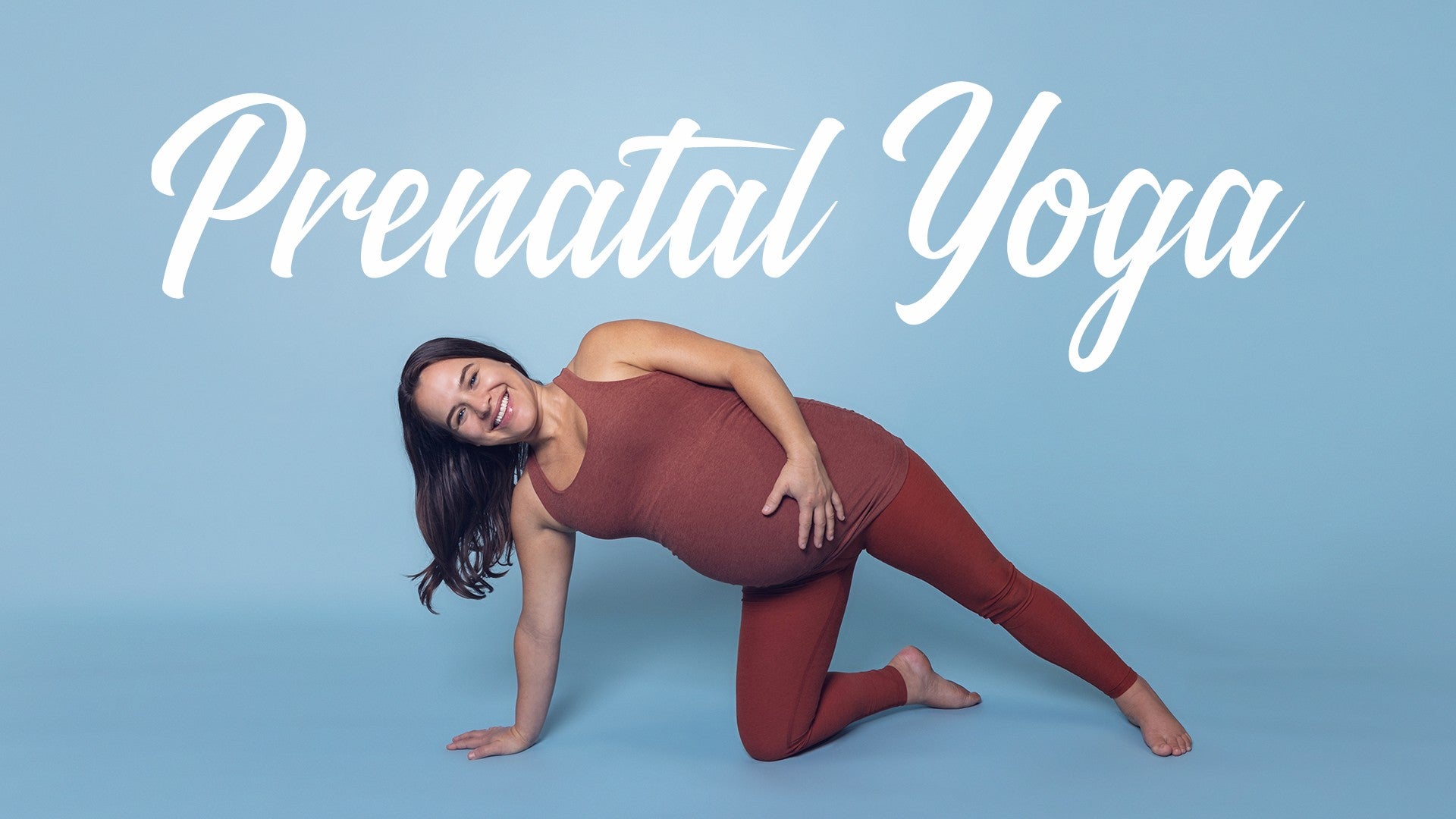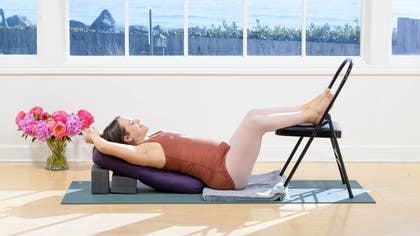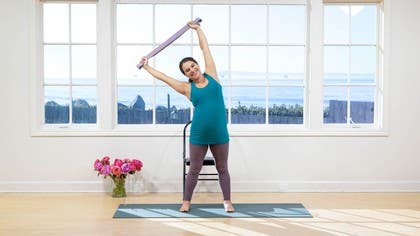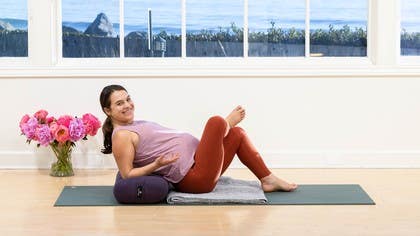Description
About This Video
Transcript
Read Full Transcript
Welcome back, nice to be together. This is a nourishing, restorative practice to help promote a sense of calm and relaxation, especially if you're feeling a bit tired, fatigue, maybe you're not sleeping well at night. This is a floor practice that I hope will feel very grounding and nourishing. So gather up the props you have, it'll be helpful to have a bolster or a couple of pillows, two blocks, a blanket, and if you have a chair nearby or a sofa, a couch, we'll have the option to bring our legs up at the end of our practice. So let's go ahead and set up in one of my all-time favorite shapes, Supta Baddha Konasana, and we're going to work with blocks underneath us.
So bring the block under your head at the second setting, and then the block directly below it at the lowest setting, so we're creating like a ramp for the body. And go ahead and place your bolster on top there, and we're going to turn around, sit down right in front of the bolster, and then go ahead and bring the soles of your feet together, let your knees go wide. And here's where having a couple of rolled-up towels under each knee can be nice, or if you're working with one blanket, you might open it up, create a roll, a nice long roll, and then a little nest for your pelvis or your hips. So bring the blanket on top of your feet, and then just tuck it underneath your knees so it feels nice and cozy and supportive. And then as you're ready, you can just recline down onto the support, and it's really worth taking the time to get it just right for your body, so you might even have an extra pillow or blanket under your head.
This is a wonderful way to open the front of the body and the chest, the shoulders, and allowing your hands, your palms to open towards the sky, feeling the shoulders softening down the back, and you might even lift your pelvis up for a moment, and feel how you can kind of curl or tuck the tailbone under as you let the lower back settle down, and feeling this kind of spaciousness and opening through your pelvis and your hips, and allowing your knees to fall towards the support, in fact, allowing the whole body to soften and release towards the support beneath you. Feeling the head slightly higher than the heart, elevated, can help reduce any heart burn that tends to happen when we're going to flatten our back, and then as you arrive and settle, notice where in the body you can soften a bit, be allowing your eyes to rest, your jaw to release, and beginning to let your attention, which might be wandering or moving around, allowing your attention to rest on the breath, and just feeling the natural rise of the inhale, and the fall or softening with the exhale, giving yourself permission to begin to let go and soften, releasing towards the support. You might keep your arms where they are, you might experiment with stretching your arms out to your sides, or even stretching your arms overhead, maybe even letting your hands rest on the bolster as you open through the lungs, the chest, the shoulders, and finding what feels right for you in this moment, honoring your own unique timing and rhythm, just about another minute or so here, allowing yourself to be as comfortable and relaxed as you can be physically, as well as emotionally, you might allow for an audible sigh, giving yourself permission to slow down and be with what is. For me in pregnancy early on, the temptation is to continually keep active and moving and push and be productive and busy, try and get everything done. Over time that just creates a pattern of doing and stress and anxiety and tension, really finding those moments to pause and rest and honor this natural cycle and rhythm that's happening within your own body.
You might stay right where you are this entire practice, just allowing yourself to drop in, sink in, and rest. As you feel ready to transition, you can bring the props out from underneath your legs and just draw your legs together and it might feel good to stretch your legs out. As you stretch your legs out, you might point and flex your feet and make some circles with your ankles in both directions. You might even stretch your arms overhead, circling out through your wrists, maybe allowing your head to gently move from side to side. Any intuitive movements here, and then eventually bend both knees, ground the feet, roll to one side, so whichever side feels right for you, you might take a moment to pause on your side and then as you're ready, use your arms, keep your head heavy, just gently press yourself up and take a moment to pause between these transitions, noticing any sounds in her movements that want to happen, and then we'll transition into a few seated shapes, so it might feel nice for this to sit up on some height.
I'm going to sit up on the bolster, and then you might have your two blocks near you. Let's come into a Baddha Konasana, seated, so bringing the soles of your feet together, knees wide, and taking a few moments to rock a little bit from side to side, just feeling your weight shifting, making space through the pelvis, and bringing the hands onto the shins. As you bring the hands onto the shins or legs, as you inhale, just feel the spine lengthen, the heart lift, the shoulders softening down the back, you might stay right here, you might slowly begin to lean forward, maybe even allowing your spine to round, maybe even releasing the weight of your head, beginning to breathe into where you feel the sensation, creating space through the pelvis, the hips. If you're working with quite a bit of sensation, sometimes a little swaying from side to side, some oscillation, a seaweed-like movement can feel good. Again, relaxing the face and the jaw and breathing into where you feel the stretch.
Take your time when you're ready to slowly make your way back up, and let's do a few butterfly flutters here, so just allowing your knees to move up and down, might even bring your hands onto your belly, feeling that work through the inner thighs, adductors, hips, a butterfly, nice, and then just pausing, and let's go ahead and keep the right foot in, we'll extend out through our left leg, and you might draw the sole of that foot in a little closer. Now depending on your body or knee, you might bring a block underneath that right knee, and then bring your other block, be at that second setting, on the inside of your left knee, our calf area, and taking a few moments to pause here, and then beginning to walk your hands forward, and of course readjusting the block, the props for you, so it feels just right, finding that appropriate edge of stretch and sensation, make sure there's plenty of room for your belly, your baby, you might find a spot where you want to pause, you might continue to walk your arms forward, and releasing the weight of your head, now feeling a lot more sensation through the inner groin and the hamstrings, softening the face. Slowly as you're ready, walk your way up, stretching that inhale, stretch the right arm up towards the sky, and just sweeping the left hand down the leg towards the shin, as you inhale, grow tall and lengthen, and as you exhale, you might find a side stretch over to the left, and you might bring your left forearm onto the block, as you reach up out and over, and just find a place where your neck feels good, maybe that's looking down or straight ahead, kind of spiraling the rib cage up towards the sky. You can keep the top arm reaching, or you might bend the top arm, support the back of the head and neck with your hand, a few more moments here, opening and stretching the side body as you breathe. As you're ready, inhale, reach with that top arm, come all the way up, and exhale, release.
As you're ready, lean back and just free that right leg, you might shake it out, lean back and bring the sole of that left foot towards the right inner leg. You might choose to bring a block or a blanket underneath that left knee, and maybe your block on the inside of that right knee or calf. You might stay upright, if you want to feel a bit more sensation, you might walk your hands forward, allow for an inhale, nice full exhale, and softening something, and I find as I soften something, lots of little something softened too. Maybe it's the jaw, the shoulders, you might choose to walk the hands a bit further and release the weight of your head. Notice the quality of your gaze.
The eyes might be softly focused or closed. You might stay here for a bit longer, you might slowly begin to walk your way up, and then inhale, reach your left arm up towards the sky, sliding the right hand down the leg as you begin to stretch up out and over towards the right, you might even bring your right forearm onto the block, find a height that feels right for you. Again, you might look down, you might revolve the ribcage up towards the sky, you might bend the elbow, the arm, and support the back of the head with your hand, feeling that big opening through the side body, the lung as you breathe, and customize it for your growing body. Last few moments here. Slow as you're ready, inhale, reach with the top arm to come up, and exhale, pause, you can bring the blocks off to the side, and then lean back, free your left leg.
Let's keep the legs wide for a few moments, allow for a exhale, and we'll inhale, sweep the right arm up towards the sky, taking it over to the left, inhale back to center, sweep the left arm up and over to the right, and let's do this a few times at your own pace, sweep the arm up and over, opening those intercostal muscles, and up and over, a few more rounds at your own pace, breathing, opening, stretching. One more in each direction, coming back up, you might stay here, you might begin to walk your hands forward, coming into a forward fold, you might have support in front of you, bolster, blankets, and allow for an inhale and exhale, softening, find that ease in the neck, ease in the jaw, you're welcome to stay longer, slowly begin to walk your way up, and we'll lean back, and let's transition into a tabletop position, so shifting your weight, find your way into tabletop, you can bring your bolster off to the side for a moment, and it might feel nice to have a blanket under your knees for some extra padding and support. Coming into tabletop position, again, fingers spreading wide apart, or if there's sensitivity in your wrists, you might lower your forearms down or bring your blocks in, bring your forearms onto your blocks at any height, and then as you're ready, inhale to lengthen and just exhale, let your back round and stretch, coming into the cat position, inhale, arching, lengthening, through the sitting bones, the collar bones, and then exhale, round and stretch, continue finding your own pace and rhythm here, while you customize it for your wrists and hands, you might even tuck your toes under if that feels good, inhale to arch, and exhale to round, nice, and then moving the hips in a circular direction, so choosing one direction and just circling the hips, make sure the knees are nice and wide to make space for your belly and baby, feeling the weight move through the hands, the wrists, or the forearms, and then circling in the other direction, really encouraging movement and mobility through your pelvis, through your hips, through your spine, nice, and then from here, take a moment to walk your hands back and you might bring your blocks with you for support, let's just get a toe stretch here for a moment, softening the face, the jaw, the shoulders, big stretch for the feet here, stretching and awakening that plantar fascia, nice, and then just slowly release and as you release, you can just kind of kick the legs, the shins, you're stamping the tops of the feet here, nice, and then moving into a side plank variation, so from here extend back through your left leg and just let yourself rock a bit from forward and back, we're going to transfer the weight into that right hand, shoulder, and stack as you open into a side plank variation, you might bring the left hand on your hip, really softening the left shoulder down the back, if it feels good, you might extend your top left arm up towards the sky, maybe even sweeping that arm over the ear as you lengthen and feel like you can really root through the outer left edge of your foot up into your hand, breathing, wonderful side body opening, inhale, exhale, sweep your left arm down, come back into your tabletop position and then cat cow through the spine, inhale to arch, exhale to round, when you feel ready, let's feel into the second side, extend back through your right leg, you might rock forward and back, waking up the back of the leg, the back, and then transferring into your left arm, stacking the shoulder over the wrist, right hand on the hip, or you might sweep that right arm up towards the sky, feeling that reach from the heart into the hands, then maybe sweeping that top right arm over the ear as you lengthen, rooting from the right outer edge to the fingers, inhale here, and then exhale, sweep the right arm down, back into your tabletop, and then bring the knees nice and wide apart as you come into a child's pose, and you might bring a block or the bolster underneath your forehead as you rest here, again knees nice and wide to make space for your belly, feeling the weight of the pelvis softening towards the heels, you might explore breath or two, down and wide into the lower back, nourishing the kidneys, down into the pelvis, beautiful, you're welcome to stay longer, of course, in child's pose, we're slowly begin to walk your way up, and let's meet in a standing forward fold at the back of the mat, so we won't stand for long, tuck the toes, feet nice and wide, and just walk your feet back as you come into that forward fold, now if you're not coming into an inversion where you're dropping the head below the heart, you might bring your forearms onto your legs as you bend the knees and come into a supported squat, and we'll pause here for a beat, and then as you're ready, press through the feet and just come up to stand for a moment, and we'll rearrange some props, we're gonna find a short series of squatting and then coming into a wide forward fold, so it'll be nice to have your two blocks as we come into a melasana squat, you might find that three blocks is useful or one block, find what feels right for you, we're gonna be sitting down on that block, and then you can have a bolster out in front of you if you'd like, it'd be really nice to have this, okay? Okay, so from standing, as you're ready, we're gonna bring the hands onto the hips, and then just with the feet nice and wide, hinge at your hips, and we're gonna come into a wide forward fold, here's where you might bring the hands onto your bolster, if you're not dropping your head today, you might just keep your head extended and lifted, or you might release the weight of your head, coming into a wide forward fold variation, and then from here, turn your toes out, heels in, bend your knees a lot, and then sit down, coming into a squat or melasana, this is a wonderful nourishing shape for pregnancy, for labor, for childbirth, for really creating space through the pelvis, the hips, the legs, softening face and jaw, I love this feeling of support underneath me, especially with more weight, still allowing for this downward flow of energy and circulation through the pelvis, from your squat, the transition will be back into a wide forward fold, you might turn the toes out, toe heel the feet a little wider, let's go side to side here, little skandhasana, you can keep your hands on the bolster, you might release your forearms onto the bolster and release your head, whatever feels right for you, and we're just bending the knees and going side to side here, feet wider than the mat, waking up the inner leg lines, the hamstrings, and then toe heel the feet closer, we're gonna take one more squat here, heels and toes out, bend your knees, bend your seat and pause, settle, soften, yeah, breathing down into the belly, feeling the movement of the breath in the belly, the pelvis, the low back, nice. One last transition as you're ready, with some momentum we're gonna shift the weight forward and up, coming into our last wide forward fold, bend the knees, you might toe heel the feet wide, maybe releasing the weight of your head, breathing, okay, coming up onto the hands, toe heel your feet a little closer together, hips width, bend the knees, hands on the hips, press through the feet and come up to stand, take a moment to just let the blood, the energy move back down, we're gonna transition back down to the floor for our final restorative shape.
As you're ready we're gonna set up one more time with the blocks on the bolster like we did at the beginning of our practice, but this time we'll elevate our legs, so you might kind of readjust so you're near a chair or even a wall, might feel really good or a couch and then go ahead and bring your chair in, you're just kind of doing your best to measure and I think it feels nice to have a blanket underneath me to pad the sacrum area, you're gonna find your way down slowly, come onto your hip and then find your way onto the bolster as you swing your legs up, again your legs might be up on a chair, up the wall, you might even prefer just lying on your back without a bolster or blocks, just taking a moment to pause. Making those adjustments so it feels just right for your body, your low back, your legs. Getting the legs up is such a wonderful way to help reduce inflammation and swelling in the ankles and feet, I've experienced quite a bit of that on a daily basis, so finding a way to elevate your legs so that they're higher than your heart can be really nice, kind of draining all of the swelling and fatigue, letting that blood and energy flush down the legs and nourishing the pelvis, the baby. And this extra support, this incline can again feel really nice if you're in a stage where you're not resting on your back. You have what's called the vena cava, this branch, this kind of channel that runs up through the spine bringing blood flow to the heart and so often you hear during pregnancy to rest on one side, maybe it's the left side that's preferred rather than the back.
So having a bit of an incline and a support can be a really nice way to rest supine, especially if you're experiencing any heartburn or feeling nauseous or dizzy. Your arms might rest out to your sides, you might bring your hands onto your belly, might even choose to bring your arms back overhead if that felt really good. Having the weight of the body to soften and melt towards the support. It's true that relaxation takes practice, for many of us it's not so easy. We need to practice moving a bit slower, giving ourselves permission to kind of drop in and let go, making that transition from all of the doing towards a quality of being.
You might stay here a bit longer, I really encourage you to stay and rest as long as you like. Even when you feel ready to transition, it can always be a bit awkward, find a way to release your legs, bend your knees and shift your weight so you're rolling onto one side and again it's whatever side feels right for you and take a moment to pause, just feeling the weight of the head heavy. You might stay and rest here a bit longer. Taking your time and slowly pressing your way up, taking a moment to pause together, feeling the support beneath you, resting in the space you've created for yourself and your baby. Feel the rise of the inhale and fall of the exhale, maybe with a sigh.
Thank you so much for being here and joining us, may this support you.






You need to be a subscriber to post a comment.
Please Log In or Create an Account to start your free trial.